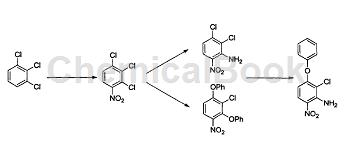Background and overview[1]
The herbicidal active compound acetofen belongs to the group of diphenyl ether organic compounds. Mixtures of these compounds with other herbicides are known in the literature. In particular, heteroaryloxyacetamides are described in combination with individual active compounds (e.g., the herbicide benzene). mixtures); however, there is no experimental data on synergistic effects. The herbicidal active compound acetofen is characterized by a broad spectrum of activity against monocotyledonous and dicotyledonous harmful plants and is used, for example, mainly by pre-emergence methods in sowing or growing agricultural or horticultural crops and on non-crop land such as cereals ( Such as wheat, barley, rye, oats, triticale, rice, corn, millet), sugar beet, sugar cane, rapeseed, cotton, sunflower, soybean, potato, tomato, beans, flax, pasture, fruit plantations, planted crops, Green spaces and lawns, as well as squares and tracks in residential or industrial areas.
Apply[2-5]
As the individual active compound, acetofen is commercially available. Benzofen is a diphenyl ether herbicide and an inhibitor of protoporin oxidase. Pre-emergent application can control broadleaf weeds and grassy weeds in sunflower, potato and winter wheat fields. Field trials on carrots, peas and broad beans showed that when applied, the control effect against windweed was 97%, and the control effect against rat-tailed wheatgrass exceeded 90%, which was equivalent to its control agent Chloromeron. The control effects on chickweed, wild sesame, pigweed, field forget-me-not, ivy, granny vine, Persian water bittern and field viola are all better than the control agent; the control effect on wheat vine and chamomile is lower than the control agent . It is safe and harmless to crops. After tilling the soil, it can be planted 4 weeks after application.
Under the trade name and in addition to the use of the individual compounds, mixtures of acetofen with other herbicides are also known in the literature and are commercially available: mixtures with amitrole (e.g. IllicoTL), Mixtures with isoxaflutole (for example Merlin), mixtures with alachlor (for example), mixtures with flurtamone (for example), mixtures with oxadiargyl ) (for example) and mixtures with oxadiazon (for example). Examples of its application are as follows:
1) Preparation of a herbicidal composition containing dicamba and acetofen and its application. The herbicidal composition contains dicamba and afeniofen as the main active ingredients, and the mass ratio of dicamba to afeniofen is 1 ~60: 1~60. The herbicidal composition of the present invention can be used for post-emergence weeding in winter wheat fields, and is particularly effective in controlling gramineous and broad-leaf weeds in winter wheat fields. Compared with a single agent, the herbicidal composition of the present invention delays weed resistance, has a wide herbicidal spectrum, has a long duration of effect, and is safe for winter wheat and subsequent crops on the premise of improving the efficacy.
2) Preparation of a herbicidal composition containing sulfomenazofen and afeniofen, in which the active ingredients are sulfomenazofen and afeniofen, and the weight ratio of the sulfonemefenacet and afeniofen is: 1:10~10:1. The present invention is used to prevent and control annual grass weeds such as brome weeds and tamarind in wheat fields. The efficacy test shows that the complementarity between the active ingredients of the composition is used to improve the control effect on weeds and make up for the need for weeding. It is beneficial to delay weed resistance and is safe for wheat crops, and has good application prospects.
3) Preparation of a preparation in the form of an aqueous dispersion, comprising the following components: acetofen and flufenacet; a mixture of anionic surfactants and nonionic surfactants, the anionic surfactants being selected from the group consisting of naphthalene sulfonates Acid or selected from the condensation product of naphthalene sulfonate and formaldehyde, the nonionic surfactant is selected from di-block and tri-block copolymers of alkylene oxide; a specific mixture of organic and inorganic thickeners; and also Other agrochemical active substances and other commonly used auxiliaries and additives are optionally added to the aqueous dispersion. The aqueous dispersion has high storage stability and is suitable for use in the field of plant protection.
Preparation[5]
Acetofen is mainly obtained from 1,2,3-trichlorobenzene through a three-step reaction, namely nitration, amination and etherification.

Main reference materials
[1] CN201380066140.2 Herbicide containing afeniofen
[2]CN201310539236.8 A herbicidal composition containing dicamba and afeniofen and its application
[3] CN201710428590.1 A herbicidal composition containing sulfonazole and afeniofen
[4] CN201780006562.9 Aqueous dispersion containing acetofen and flufenacet
[5] Optimization of the synthesis process and dosage form research of the herbicide afeniofen


